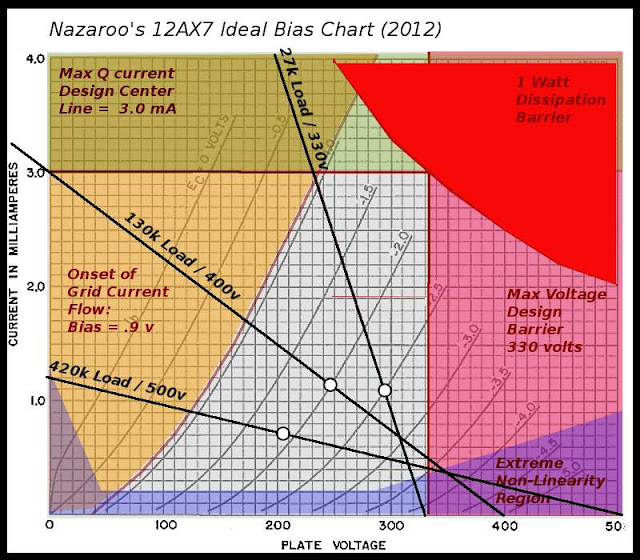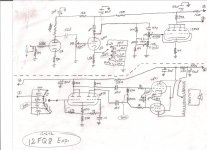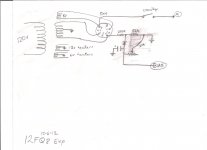I started putting together a guitar amp using some of the many 12fq8 tubes I scored from a wurlitzer organ the other day. I saw many articles where people used them to build a low voltage pedal but I thought with a 330v plate limit that it would be cool to put them to use closer to that spec. I have been useing 12ax7 type values for plate and cathode resistor with some success but found that their best performance is from paralleling all the plates (4 of them) together and useing each tube basically as one triode (grids paralleled also). I am no wizard at this stuff but not totaly dumb. Currently in that arrangement I am running 39k plate resistors and 1.5k cathode resistors. I have two gain stages seperated by a 1meg volume pot & coupling cap connected to a 12fq8 longtailed pair phase invertor useing basic fender resistor values. It is starting to sound cool but I am wondering if technicaly My plate and cathode resistors are close to correct. I do not have a full understanding of the math and theroy involved and hoping you guys could give me some guidence. The four plates throw me a curve ball. Thanks
well some of the other people already answered this in a different thread.
heres the chart:

and here is the thread:
http://www.diyaudio.com/forums/tubes-valves/193829-12ax7-perfect-bias-point-2.html
heres the chart:

and here is the thread:
http://www.diyaudio.com/forums/tubes-valves/193829-12ax7-perfect-bias-point-2.html
Well that's the chart for a 12ax7 not a 12fq8, also it does not address the two triodes and 2 plates parrelled, does it? was hoping to get a little more help. I started by using the rule of thumb that you double the plate resistance (76k) to get your plate resistor (152k), but all four plates are paralleled so I divided it by 4 (38k). But the data sheet says that the plate resistance is 76k if the other plate in that section is grounded. Not sure how that affects my factoring because it is not grounded. I am not confident at reading the chart so at this point I punted with my cathode resistor.
12fq8 was a tube used in a Wurlitzer organ as a ossillator. there are like 28 of them in each organ. They are unique because they are a twin triode with four plates and a common cathode. their specs are somewhat similar spec-wise to a 12ax7. I was hoping to put them to use and see how they sounded in an audio circuit partialy because I am curious but also because I have 28 of them and I am cheap! also I couldn't find anywhere on the web where someone has done it. I found that using each triode seperately didn't seem to work. they seemed to ossilate with two different size signals going on so close to each other internaly so I decided to parallel them up. This is currently working. It was also my understanding that they were lower current tubes so I though this arrangment might help in that regard. As far as grounding the plate, that was in referance to a note on the data sheet talking about how the plate resistance is measured. 12FQ8 pdf, 12FQ8 description, 12FQ8 datasheets, 12FQ8 view ::: ALLDATASHEET :::
I'm having good results but would like to turn this project into a bigger learning expierience. Thanks, Fred
I'm having good results but would like to turn this project into a bigger learning expierience. Thanks, Fred
I found this article the other day and it was very helpful. How to "Screw Around" Your Tube Load Line.
Looks like my guessing and reasoning has me in a good range.
Looks like my guessing and reasoning has me in a good range.
I have been having some success getting good tones form this amp but am finding that either I have twenty eight badly worn out tubes or they are not really suitable for the sensitive v1 position. Some of them have an excessive hiss, some buzz and some seem exceptionaly microphonic in the that spot, v2 and v3 seem okay. I either needed to rethink v1 or find some nos tubes and give them whirl. I made the tough desicion (not that tough, I am cheap) to replace v1 with a 12ax7, I took the opportunity to use both triodes of the 12ax7. The tone has become a bit more typical and less unique but still able to retain most of what I think may be the 12fq8 "sound". I will be submiting a schematic once I finish tweeking it.
Last edited:
Cool idea using them; I would also, if I had a small stash as you, but asking them to work well in the critical V1 position is a little bit too much 
Although being as cheap as you, I'd first go from the input jack to a single Fet stage, or even a 10x gain TL072 or something (which would be "transparent", being far from overdrive) and only *then* continue to any old worn gassy tube I might be wanting to use.
Although being as cheap as you, I'd first go from the input jack to a single Fet stage, or even a 10x gain TL072 or something (which would be "transparent", being far from overdrive) and only *then* continue to any old worn gassy tube I might be wanting to use.
I Need To Make Note of a Couple Corrections to the Schematic.
On the "shift" switch the top switch contact should only be connected to the 10k resistor, there should be no connection to ground.
Also my brother pointed out that I left off values for the bias pot and cap. That pot was 25k and the cap is 100uf 50v.
On the "shift" switch the top switch contact should only be connected to the 10k resistor, there should be no connection to ground.
Also my brother pointed out that I left off values for the bias pot and cap. That pot was 25k and the cap is 100uf 50v.
I'm also a newby to tubes, and I've also thought about paralleling the sections of small-signal triodes for more current. But in theory I imagine each section probably should each have some independence in their B+ resistors and grid resistors too, pretty much like paralleled output tubes. Otherwise, for one thing, their internal capacitances add up and they start limiting bandwidth as the high end gets cut off (perhaps even worse due to miller effect?). And in reality I wonder whether they just get more noise and wonder what I need more current for, unless I was trying to drive more output tubes or something like that.
Well in this case my reason for running them in parallel was because they seemed incapable of have two different signal operating internaly. ossilations like when sensitive inputs get too close to strong output signals. That may have been because I came to this conclusion early in my "playing" phase. It is possible that now with some of the adjustments I have made to the plate resistors and cathode sections it might work. Now I have a much smaller plate resistor than I did originaly. As far as the effects of running them parallel. I notice no real loss of frequency response, at least any I care about. Matchless amplifiers run lots of their amps with 12ax7 in parallel and they sound awesome. From what I understand there is little to no increase in gain but lessnoise and better frequency response in that arrangement. those are definite reasons in my book. I also think that in the case of something like a tone stack following the stage, the paralled tube stage might "push" it better. I also in some ways are a newbie. I get some of the theory, but have a long way to go. I have built, modified and repaired several amps and the bottom line always is not theory but how it sounds. That by no way means I don't care about it. I have a genuine quest to figure out as much as I can. I find understanding the theory and seeing it in action super cool.
- Status
- This old topic is closed. If you want to reopen this topic, contact a moderator using the "Report Post" button.
- Home
- Live Sound
- Instruments and Amps
- 12FQ8 Guitar amp questions
 Moved to Instruments & Amplifiers per forum policy
Moved to Instruments & Amplifiers per forum policy
